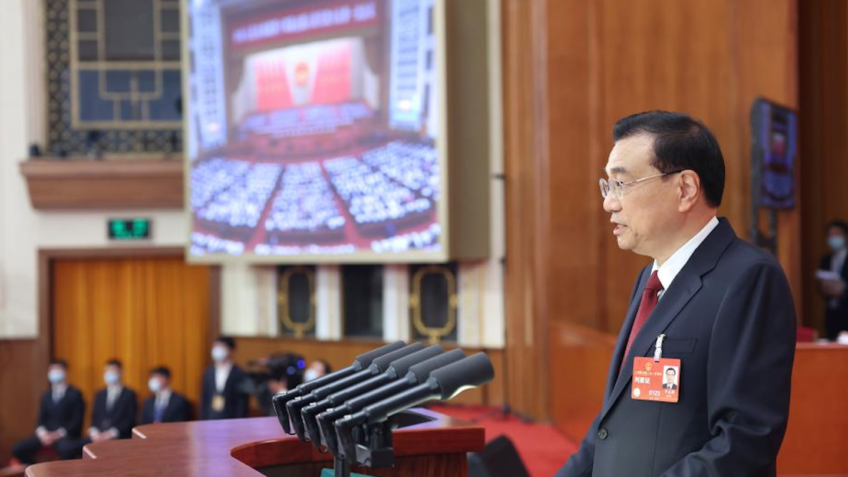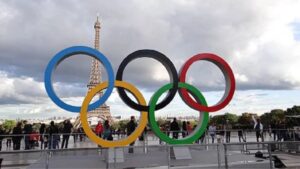
Published 06/03/2023 16:59 | Edited 03/08/2023 16:01
China set a 5% target for economic growth in 2023 on Sunday at the opening of the annual session of its National People’s Congress (NPC), which aims to implement a major government overhaul within a decade. The international market was frustrated with the predicted low index, but assesses that China should easily surpass this target.
In his work report, outgoing Prime Minister Li Keqiang emphasized the need for economic stability and expanding consumption, setting a target of creating around 12 million urban jobs this year, above the target of the last year of at least 11 million.
The economy had one of its weakest performances since 1976, last year, when the Gross Domestic Product (GDP) grew by just 3%, pressured by three years of covid controls and a drop in exports. The real estate sector suffered a crisis of confidence after a wave of defaults among property developers left dozens of housing projects unfinished.
Li has set a budget deficit target of 3.0% of GDP, up from the target of around 2.8% last year. He warned of the unstable global economy in his address to nearly 3,000 delegates at the annual meeting, which ends March 13.
“Global inflation remains high, global economic and trade growth is losing steam, and external attempts to crack down and contain China are increasing,” Li said, in a thinly veiled reference to intensified geopolitical competition with the US.
“At home, the foundation for stable growth needs to be consolidated, insufficient demand remains a pronounced problem and expectations from private investors and companies are unstable,” he said of the drop in exports.
Under pressure
This year’s growth target is at the lower end of expectations. It is below last year’s target of around 5.5%. An underestimation that avoids greater stimuli that can generate structural imbalances (budget deficit). It also considers unfavorable external pressures.
China’s state planner has said it aims to increase the income of low earners and bring more people into the middle income group. The premier disclosed measures to stimulate consumption, but did not mention direct spending.
To boost growth, the government plans to maintain its infrastructure spending playbook, boosting funding for high-value projects with 3.8 trillion yuan ($550 billion) in special local government bonds, up from 3.65 trillion yuan last year’s yuan.
A key issue to watch over the coming months is how new leaders will build private sector confidence. This is more important than fiscal and monetary policy, in the opinion of some economic analysts.
Li, 67, and a roster of more reform-minded political officials are expected to retire during the congress, clearing the way for supporters of President Xi Jinping, who secured an unprecedented third term at the top of the Communist Party Congress. of October.
During the NPC, 63-year-old former Shanghai party chief Li Qiang, a longtime ally of Xi, is set to be confirmed as prime minister, tasked with reinvigorating the world’s second-largest economy.
Parliament will also discuss Xi’s plans for an “intensive” and “broad” reorganization of state entities and the Communist Party, state media reported on Tuesday.
Military budget increase
Li said China’s armed forces, the world’s second-largest by spending, should devote more energy to training in combat conditions; and the budget included a 7.2% increase in defense spending this year, slightly larger than last year’s budgeted 7.1% increase and again exceeding expected GDP growth.
On Taiwan, Li struck a moderate tone, saying China should promote the peaceful development of cross-strait relations and advance China’s “peaceful reunification” process, but also take resolute steps to oppose Taiwan’s independence.
Beijing faces several challenges, including increasingly strained relations with the United States, which is trying to block its access to cutting-edge technology. Beijing will also focus on self-sufficiency in science and technology, Li said, as Washington imposes restrictions on Chinese semiconductor and artificial intelligence technology, citing national security concerns.
There is a worsening demographic outlook, with birth rates plummeting and population falling last year for the first time since 1961.
China plans to reduce the costs of childbirth, childcare and education and will actively respond to an aging population and declining fertility, the country’s state planner said in a work report released on Sunday.
The NPC, the country’s annual legislative event, opened on an overcast day amid tight security in the Chinese capital, with 2,948 delegates gathered in the Great Hall of the People on the west side of Tiananmen Square.
economic recovery
The first two months of the year have seen a robust comeback for China’s economy following the country’s easing of its COVID-19 response policy. The Spring Festival travel spree and the resulting surge in consumption have restarted the Chinese economy and boosted confidence in its speedy recovery.
Many sectors experienced a sharp increase in their revenues over the holiday, some reaching 80% or more of their pre-pandemic level and others reaching levels higher than even the 2019 value. Manufacturing activity in February, for example, exceeded expectations, expanding at the fastest pace in over a decade
This renewed economic boom was also evident in dynamic productive activity and a flurry of construction projects. Some companies were forced to launch a spring recruitment drive in efforts to expand their workforce enough to handle increased orders. Meanwhile, China’s lifting of Covid quarantine restrictions has triggered an influx of international visitors. CEOs and managers of international corporations are delighted with the restored convenience of air travel to China and the opportunity to meet their Chinese partners in person.
The general picture of the restarted Chinese economy focuses on areas such as tourism, foreign trade and international cooperation.
The International Monetary Fund (IMF) said China’s economy is expected to recover to 5.2% this year as household spending and business activity picks up. Industrial production last month rose at its fastest pace in a decade after Beijing abandoned its strict “zero Covid” policy in December.
Source: vermelho.org.br

